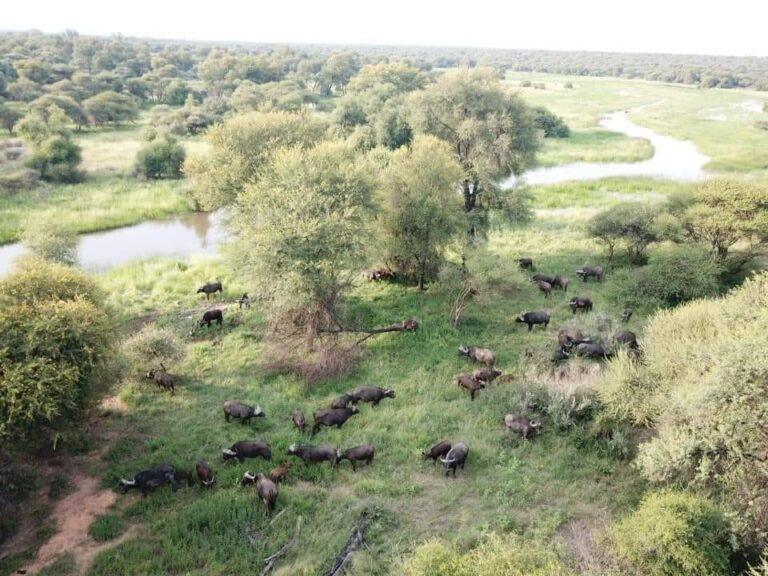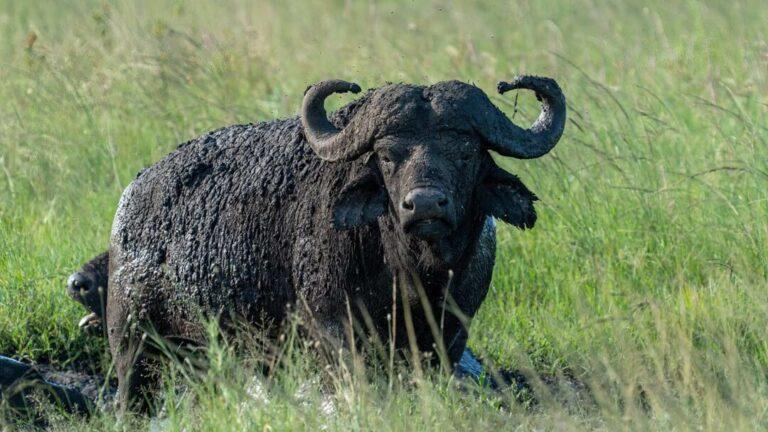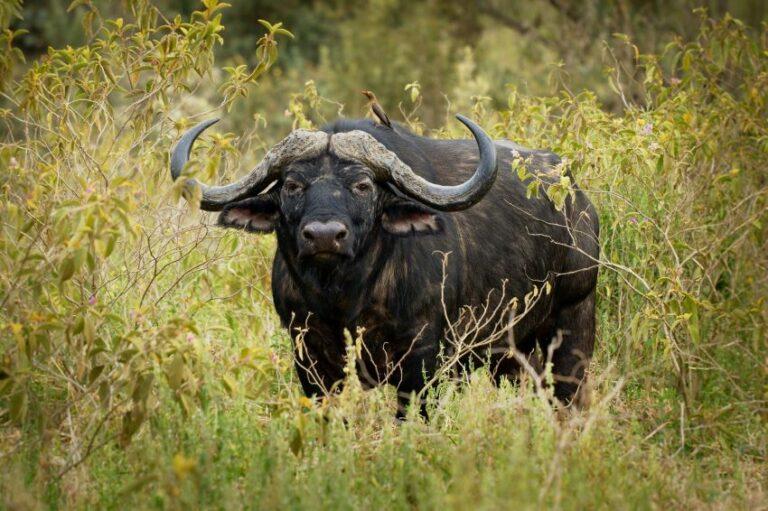Cape buffalo hunting is one of the most sought-after experiences for game hunters exploring Africa’s wild landscapes. Known for their unpredictable nature and immense strength, these animals present a unique challenge that draws hunters from around the world. Their reputation as dangerous game is well-earned, as a wounded buffalo can circle back and charge without warning, making every encounter a test of skill and preparation.
What makes this hunt even more intriguing is the behavior of older bulls, often referred to as “dagga boys.” These solitary giants, recognizable by the dried mud coating their backs, are known to separate from the herd and roam alone. Pursuing such formidable creatures requires not only expertise but also a deep respect for their power and resilience. For those seeking an authentic and thrilling safari experience, Cape buffalo hunting stands out as a true test of courage and precision.
[DYNAMIC-BLOGTABLEOFCONTENT]
Key Takeaways
-
Cape buffalo hunting offers a thrilling and challenging experience, known for testing hunters’ skill and precision due to the animal’s unpredictable nature and immense strength.
-
Mature bulls, known as “dagga boys,” present a unique challenge as they often separate from the herd, requiring expert tracking and respect for their resilience.
-
Top destinations for Cape buffalo hunting include Tanzania, South Africa, Zimbabwe, and Mozambique, each offering diverse landscapes and healthy buffalo populations.
-
The optimal hunting periods are during the dry season, which provides better visibility and accessibility, with prime months varying by country.
-
Ethical hunting practices, such as targeting mature bulls and working with licensed operators, ensure sustainable conservation efforts and compliance with local regulations.
-
Cape buffalo hunts can be combined with other game hunts, including dangerous game like lions or plains species like kudu, for a comprehensive African safari experience.
About Cape Buffalo
Cape buffalo, scientifically known as Syncerus caffer, stand among the most iconic animals encountered in big game hunting in Africa. Their immense size, resilience, and defiant nature make them both a prized and challenging target for hunters worldwide.
Characteristics Of The Cape Buffalo
Cape buffalo are robust mammals native to sub-Saharan Africa. Males can weigh up to 800 kg (1,764 lbs) and females around 750 kg (1,653 lbs). Their average shoulder height ranges between 1.4 m (4.6 ft) for males and 1.3 m (4.2 ft) for females. They possess a dark, coarse coat and frequently cover themselves in mud to shield their skin from the sun, earning older bulls the nickname “dagga boys.” These mature bulls often isolate themselves from herds, requiring heightened expertise for successful tracking.
Both males and females feature horns, but trophy bulls are identified by their thick, solid horn bosses atop their foreheads. By the age of seven, the bosses harden, making horn spread and boss condition crucial indicators for trophy evaluation. Known for their acute senses, Cape buffalo are intelligent, with unpredictable behavior that adds to the risk of buffalo hunting.
Why Cape Buffalo Hunting Is Unique
Hunting Cape buffalo differs from other African big game hunts due to their infamous reputation for danger. Wounded buffalo are known to double back, ambushing hunters along their trail. Their loud death bellows—though not always present—are considered a sign of a fading buffalo, but caution remains imperative. Each encounter demands skill, precision, and respect for the animal’s strength and instincts.
Cape buffalo hunts immerse hunters in the rugged wilderness, typically involving early morning or late afternoon tracking when buffalo graze in open areas. The preferred firearm minimum for Cape buffalo hunting is a .375 caliber rifle, ensuring sufficient power to take down these formidable animals effectively. For hunters seeking an unparalleled adventure, African Cape buffalo hunts blend challenge, thrill, and the preservation of traditional hunting practices.
Where To Hunt Cape Buffalo
Cape buffalo hunts offer diverse options across Africa, with specific regions excelling in game hunting due to their healthy buffalo populations and well-preserved ecosystems. Selecting the right country and location ensures a rewarding and challenging hunting experience.
Top African Countries
-
South Africa: Known for its established game hunting industry, South Africa delivers organized and regulated buffalo hunting experiences. Game reserves and private areas ensure both safety and high-quality hunts for beginners and experienced hunters alike.
-
Tanzania: Tanzania stands out for its vast wilderness areas, including the Selous and Maswa Game Reserves. As home to significant buffalo populations, it offers some of the most authentic African Cape buffalo hunts.
-
Zimbabwe: Famous for its National Parks like Hwange and the Zambezi Valley, Zimbabwe is a top destination. Trophy-quality buffalo bulls and challenging terrain make it a prime choice for seasoned hunters.
-
Mozambique: Mozambique, especially around the Zambezi Delta, offers remote hunting grounds. Its less commercialized hunting operations provide raw and adventurous buffalo hunting experiences.
Best Hunting Locations
-
Selous Game Reserve (Tanzania): One of Africa’s largest protected areas, this reserve teems with Cape buffalo. Its remote setting provides an authentic hunt in untouched wilderness.
-
Kruger Private Reserves (South Africa): Adjacent to Kruger National Park, these reserves manage thriving buffalo populations, ensuring prime opportunities for hunters.
-
Zambezi Delta (Mozambique): Renowned for vast floodplains and diverse wildlife, this area is ideal for those seeking a demanding buffalo hunt.
-
Zambezi Valley (Zimbabwe): Rugged terrain and roaming “dagga boys” make it a sought-after destination for big game hunting in Africa.
For any African Cape buffalo hunts, pair these locations with experienced guides to maximize safety and success. Applying for packages through trusted platforms simplifies planning, ensuring a seamless experience.

When To Hunt Cape Buffalo
Cape buffalo hunts are most successful during specific times of the year when conditions offer better visibility and accessibility. Timing greatly impacts the overall hunting experience, as buffalo behavior and environmental factors fluctuate across seasons.
Best Months For Hunting
The best months for Cape buffalo hunting align with the dry season in various African regions. The scarcity of water during these months brings the buffalo closer to water sources, allowing for easier tracking. In South Africa, the prime season is May through September, while Tanzania and Zambia recommend hunting between July and October. Zimbabwe offers excellent opportunities from April to October, and in Mozambique, the hunting season extends from April to November.
Dry conditions offer additional advantages. Shorter grass during these months increases visibility, making it easier to locate and assess trophy bulls. Buffalo tend to move in herds, but during the dry season, mature bulls, often called “dagga boys,” separate from the group, making them easier to track individually.
Seasonal Considerations
Seasonal variations influence both the hunting landscape and the behavior of Cape buffalo. During wetter months, dense vegetation and muddy terrains can complicate tracking. This is why countries like Namibia restrict hunting in January and February. Similarly, in Mozambique, the heat and humidity in October and November, particularly in swampy regions, can make the hunt physically challenging for even experienced hunters.
Conversely, dry months not only provide better visibility but also allow more access to remote hunting areas critical for successful Cape buffalo hunts. Temperatures during this time, while varying, are generally more manageable, with cooler evenings offering relief after daytime hunts. Regardless of the weather, staying prepared for diverse conditions ensures safety and success.
Understanding the timing and seasonal constraints is essential when planning African cape buffalo hunts. Focus on periods when the environment favors tracking and buffalo movements increase the likelihood of success.

Hunting Methods
Cape buffalo hunts are known for their demanding and immersive nature, combining skill, endurance, and strategy. Whether through rifle or bow hunting, or by employing specific stalking techniques, hunters can experience a true test of their abilities while pursuing this formidable game.
Rifle Hunting
Rifle hunting remains the most common method for African cape buffalo hunts. A minimum caliber of .375 is essential to ensure an ethical and effective takedown of such a resilient animal. Many hunters prefer larger calibers like .416 or .458, especially for up-close encounters. Precision is key, particularly for the first shot, as wounding the animal can provoke aggressive and unpredictable behavior. Hunters aiming for trophy-quality bulls often rely on professional guides and trackers to locate and position them within optimal shooting distances, typically between 40 and 80 yards. Practicing accurate shots from various positions, such as standing freehand or supported, improves preparation for the hunt.
Bow Hunting
Bow hunting offers a unique challenge for buffalo hunting enthusiasts seeking a close-quarters, skill-intensive experience. To penetrate the thick hide and muscles of a Cape buffalo, hunters use bows with a 70–90 lb draw weight and heavy, solid broadhead arrows designed for maximum penetration. Bow hunters often choose ground blinds or natural cover near waterholes, where buffalo regularly gather to drink, particularly during the dry season. Walking and stalking is another popular technique, although it demands exceptional patience, silent movements, and complete reliance on wind direction. Success at close range, usually 20–30 yards, depends on precise shot placement, aiming for vital areas like the heart or lungs.
Stalking Techniques
Stalking Cape buffalo often requires tracking on foot through rugged landscapes, thick brush, or open savannahs. Tracks are usually found near waterholes or in freshly disturbed ground, signaling the presence of a herd or solitary bull. Skilled trackers analyze spoor to identify trophy bulls, discern their direction, and estimate their distance. Once the bull is nearby, silence becomes critical, as hunters depend on minimal sound and hand signals for communication. Closing the distance requires careful maneuvering through dense vegetation, with frequent stops to assess direction and avoid detection. Hunters may only catch glimpses—such as hoofs or shadows—before setting up for the critical shot. A strong wind advantage is crucial to conceal human scent and approach unnoticed.
For those searching for buffalo hunting packages, these traditional methods offer immersive big game hunting in Africa. Each hunt provides opportunities to build skill and experience while appreciating the formidable nature of the Cape buffalo.
Planning Your Cape Buffalo Hunt
Organizing a Cape Buffalo hunt involves careful coordination of equipment, budget, and ethical considerations. Whether for seasoned hunters or those new to buffalo hunting, strategic planning ensures a rewarding experience.
Shot Placement And Recommended Caliber
A well-placed shot is vital during African Cape Buffalo hunts to ensure an ethical takedown. The recommended minimum is a .375 caliber rifle, though larger calibers like .416 or .458 are often preferred for their superior stopping power. Hunters using .375 often opt for soft-point bullets for the initial shot to reduce overpenetration risks. Solid bullets are advised for follow-up shots, ensuring deep penetration. Precision in shot placement is key—aiming for the shoulder or heart-lung area minimizes unnecessary suffering and increases success.
Costs And Packages
Buffalo hunting packages vary across hunting destinations, reflecting inclusions like professional hunting guides, permits, lodging, and duration. The cost often starts at $10,000 and may exceed $20,000 for premium experiences. Game Hunting packages tailored to include additional species or luxury accommodations can further influence pricing. Offering both economy and high-end options ensures accessibility for diverse hunting preferences. Reviewing Buffalo hunting listings helps hunters select packages fitting their needs.
Ethical And Sustainable Practices
Ethical hunting remains a cornerstone of Cape Buffalo hunts. Collaborating with licensed hunting operators ensures compliance with conservation efforts. Sustainable practices, such as targeting mature bulls, support population balance while preserving future hunting opportunities. Hiring certified trackers and adhering to local hunting regulations enhance the responsible nature of your hunt. This approach aligns big game hunting in Africa with both cultural respect and ecological balance.

Additional Hunting Opportunities
Cape buffalo hunts are often the centerpiece of African cape buffalo hunts, but the adventure doesn’t have to end there. Expanding the experience with a variety of additional game species adds depth and variety to the journey, offering hunters a chance to explore even more of Africa’s wild landscapes.
Dangerous Game Hunting
For those eager to face Africa’s biggest challenges, dangerous game hunting offers an unmatched test of skill and determination. These hunts target the iconic Big Five (lion, leopard, rhino, elephant, and buffalo), with some packages including species like crocodile and hippopotamus. Dangerous game hunts take place in rugged terrains, from thick bush to open savannahs, where preparation and precision are vital to success.
Combining Cape buffalo hunts with dangerous game creates a truly remarkable African hunting experience. However, these species often require permits and special arrangements to ensure ethical and sustainable practices. Hunters typically work closely with professional guides to navigate local regulations while enjoying a safe hunt.
Plains Game Hunting
Plains game hunting introduces hunters to Africa’s diverse antelope species and relaxed tracking methods compared to buffalo hunting. Popular species include kudu, impala, springbok, and steenbok, each offering unique behavioral patterns and trophy potential. These hunts often take place in open grasslands or light woodlands, allowing plenty of opportunities to practice stalking and shooting skills.
Many African hunting packages pair Cape buffalo hunts with plains game hunts for a well-rounded adventure. This combination allows hunters to enjoy both high-intensity and more laid-back pursuits. Additionally, the abundance of plains game across Southern and Eastern Africa makes these hunts accessible, even for those new to game hunting.

Conclusion
Cape buffalo hunting offers an unmatched blend of challenge, excitement, and tradition, making it a must-experience for passionate hunters. The combination of skill, strategy, and respect for these formidable animals creates a deeply rewarding adventure that stays with us long after the hunt is over.
By choosing the right location, timing, and method, we can elevate our hunting experience while contributing to ethical and sustainable practices. With proper preparation and trusted guides, the thrill of tracking these legendary creatures becomes a journey of both personal growth and unforgettable memories.
Frequently Asked Questions
What makes Cape buffalo hunting so dangerous?
Cape buffalo are highly unpredictable animals, especially when wounded. A wounded buffalo can ambush or charge hunters unexpectedly, making them one of the most dangerous game species to hunt.
What rifle caliber is recommended for hunting Cape buffalo?
The minimum recommended caliber for hunting Cape buffalo is .375 H&H. Many experienced hunters prefer larger calibers, like .416 or .458, for their greater stopping power in close encounters.
When is the best time to hunt Cape buffalo?
The best time to hunt Cape buffalo is during the dry season when they gather near water sources. In South Africa, the prime months are May to September, while Tanzania, Zimbabwe, and Zambia are best from July to October.
Where are the best locations for Cape buffalo hunting in Africa?
Top locations for Cape buffalo hunting include the Selous Game Reserve (Tanzania), Kruger Private Reserves (South Africa), Zambezi Valley (Zimbabwe), and Zambezi Delta (Mozambique). Each offers unique terrains and buffalo populations.
What are the costs of a Cape buffalo hunting package?
Cape buffalo hunting packages typically start at $10,000 and can exceed $20,000, depending on inclusions like guides, accommodations, and trophy fees.
Are there ethical implications to hunting Cape buffalo?
Ethical hunting practices are essential for sustainability. Reputable operators follow local regulations and support conservation, ensuring buffalo populations are maintained responsibly.
What is a “dagga boy” in Cape buffalo hunting?
“Dagga boy” refers to older, solitary male Cape buffalo. These bulls are prime targets for trophy hunters due to their thick horn bosses and challenging behavior.
Can Cape buffalo be hunted with a bow?
Yes, bow hunting is an option, but it requires specialized equipment. A bow with a 70–90 lb draw weight and heavy arrows is needed to ensure ethical and effective penetration.
What other game can be hunted alongside Cape buffalo?
Many packages combine Cape buffalo with dangerous game like lions, leopards, and elephants, or plains game like antelope. This creates a diverse and immersive hunting experience.
Why is the first shot crucial in Cape buffalo hunting?
A precise first shot is critical in Cape buffalo hunting as it ensures a quick and ethical takedown. Poor shot placement can wound the buffalo, increasing aggression and danger.
